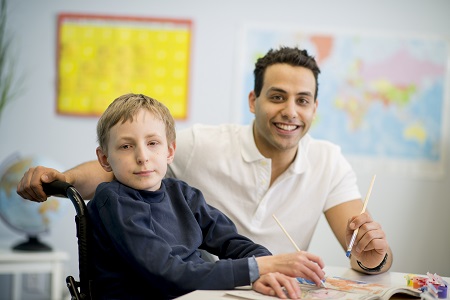Students with Disabilities
“When a task is given in school,
why does one student take thirty minutes to complete it
and another only eight minutes?”
1 Graduate Credit
- Grading: A-F
- Materials: Included in the course fee!
- Graduate Credit: 1 Graduate Credit
- Instruction Mode: Self-paced, Asynchronous (Online Class)
- Time Frame: Enroll and start any time
Course Description:
Every classroom is diverse and with students who are unique and have different needs, learning levels and abilities. While it is certainly challenging to teach all students effectively, this is very much a real possibility.
This online course can help teachers realize every student’s potential for academic excellence. SECTION A: Accommodations through UDL presents teachers with a research-based framework to accommodate every learner and provides practical strategies that can be used to add elements of flexibility in teaching presentation, student expression and meaningful engagement.
SECTION B: IEPs: Documentation and Implementation for Teachers aims at helping teachers to understand the IEP process and uses rich examples for designing, planning and implementing an IEP.
SECTION C:Assistive Communication for Every Classroom introduces teachers to assistive communication techniques that can improve classroom communication for students with disabilities. It explores tools, strategies and technologies that can be implemented for teachers to create an inclusive classroom and a positive learning environment for students with disabilities.
See inside this course…
Objectives & Outcomes:
As a result of successful participation in SECTION A, Accommodations through UDL, students should be able to:
- Design comprehensive curriculum and effective assessments with the Universal Design of Learning (UDL).
- Incorporate audio-visual and textual options, variety in language, mathematical expressions and symbols in presentations for learning.
- Integrate Flexible Methods of Expression for differently-abled students to be challenged and engaged with the learning environment.
- Employ strategies such as self-regulatory skills and eliminating distractions to enhance student learning.
As a result of successful participation in SECTION B, IEPs: Documentation and Implementation for Teachers, students should be able to:
- Explain the IEP process and successfully participate as an IEP team member.
- Identify and use accommodations, modifications and differentiation instruction techniques to address students’ specific areas of need.
- Implement a standards-based Individualized Education Plan (IEP).
As a result of successful participation in SECTION C, Assistive Communication for Every Classroom, students should be able to:
- Define the purpose and process of assistive communication.
- Explore the benefits, types and categories of assistive communication devices and technologies.
- Identify student’s needs to tailor pedagogy.
- Facilitate communication and learning for students with disabilities through assistive communicative tools and strategies.
- Integrate low-tech and high-tech assistive communication.
- Sense the laws promoting and supporting assistive communication devices in the classroom.
Special Instructions:
After completing the course, you will be directed to the university for registration.


